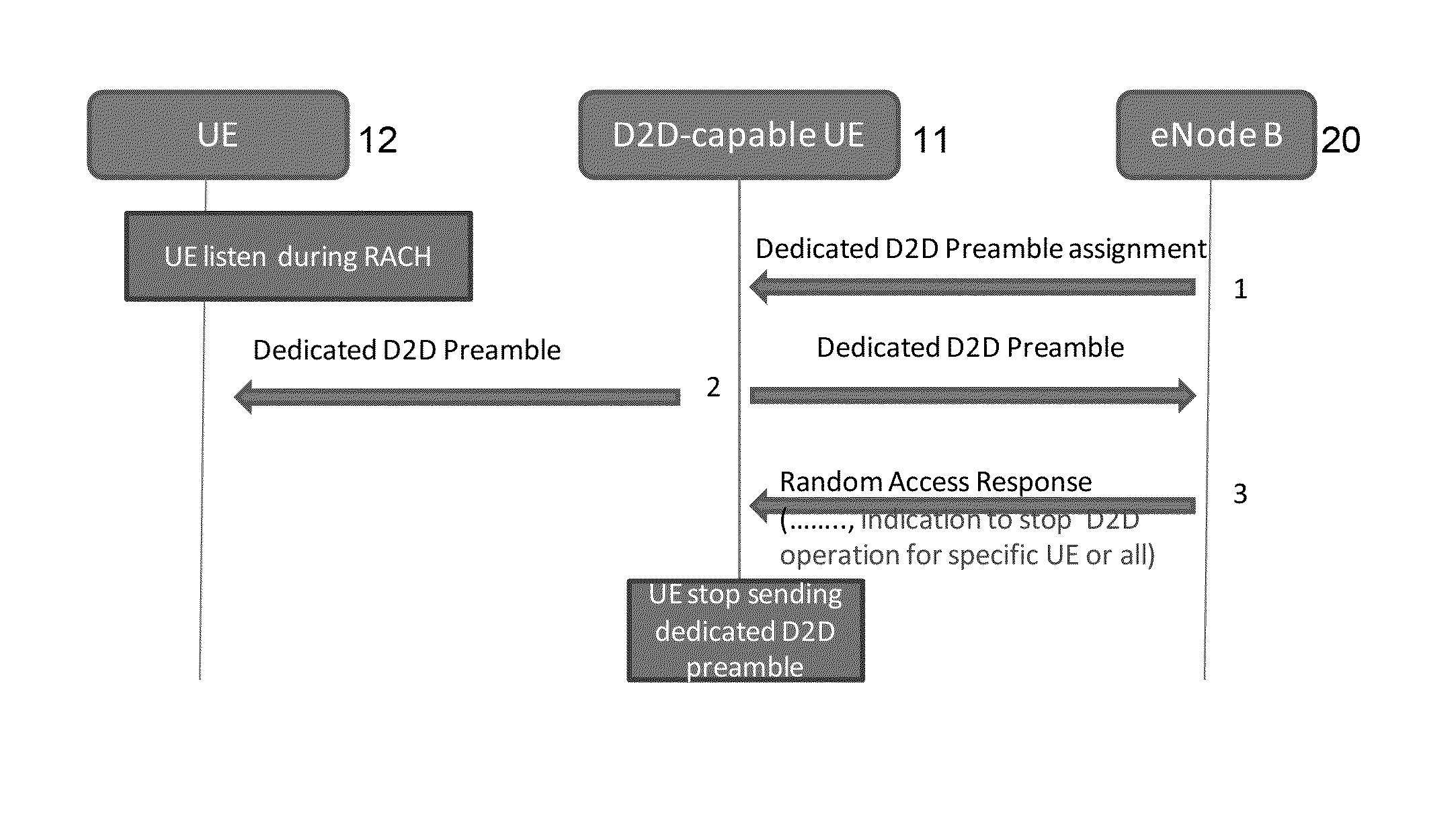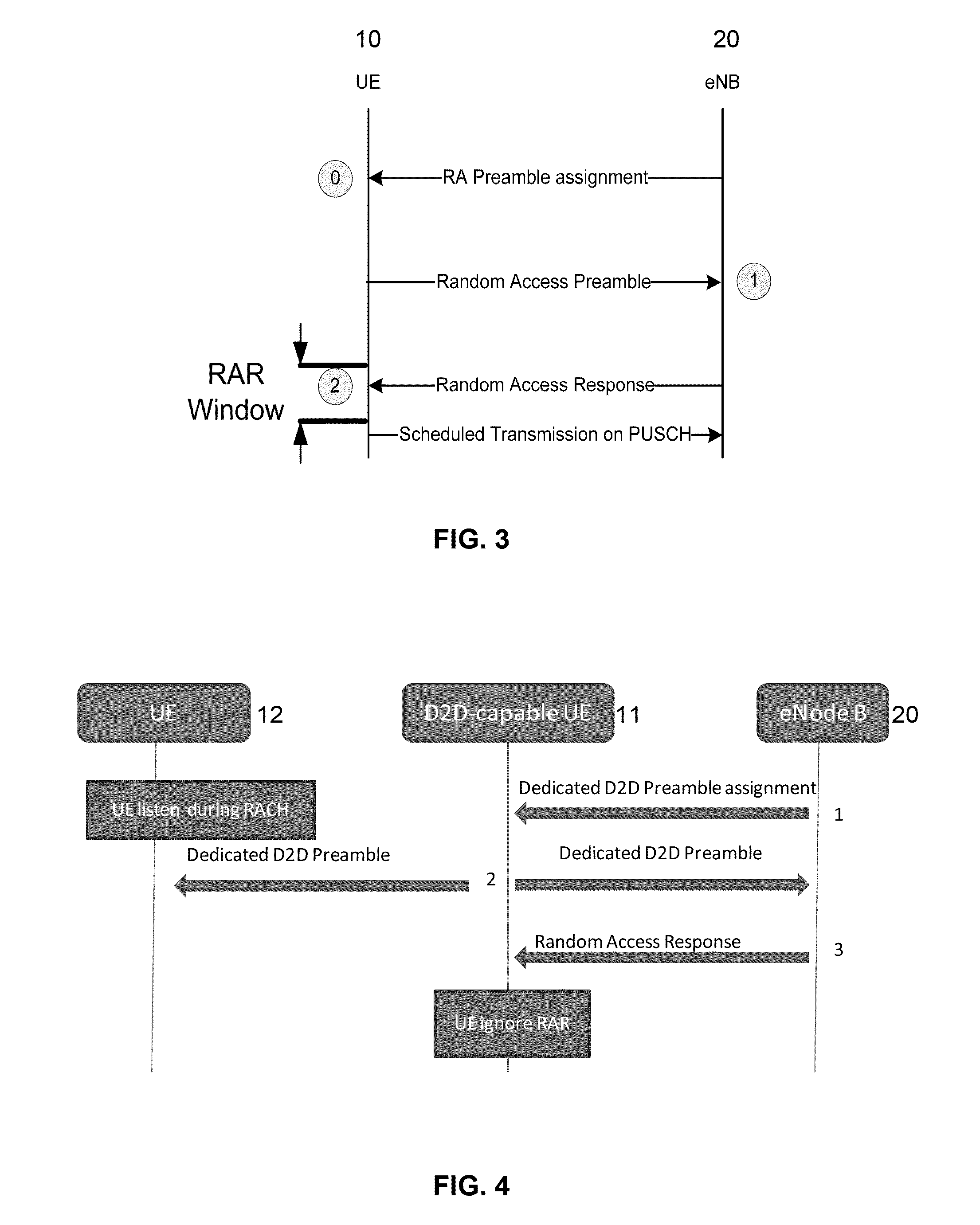D2d communication in wireless networks
a wireless network and communication technology, applied in the field of wireless communication networks, can solve problems such as the risk of collision, and achieve the effect of reducing the overhead of control signalling and enhancing the rach procedur
- Summary
- Abstract
- Description
- Claims
- Application Information
AI Technical Summary
Benefits of technology
Problems solved by technology
Method used
Image
Examples
first embodiment
[0112]In a first embodiment, the contention free-based RACH procedure is modified as follows. Steps 1-3 described below are illustrated in FIG. 4.
1. The eNodeB assigns a dedicated preamble for the purpose of D2D communication and sends it to a D2D-capable UE. The preamble is specific to that D2D-capable UE (hence contention-free). The lifetime of this dedicated preamble is a variable parameter and some ways of modifying it (and even stopping the usage of a certain RACH preamble for this purpose) are detailed in subsequent embodiments.
2. The D2D-capable UE will then RACH with the assigned “D2D preamble” to advertise its D2D capability to any other UE within range of the preamble signal. A UE needing a D2D link will listen during the RACH period to identify the dedicated D2D preamble and to identify the D2D-capable UE; this is a change to the conventional RACH procedure.
[0113]In a refinement of Step 2, the transmit power for the broadcast of the dedicated D2D preamble can vary and in ...
second embodiment
[0118]In the second embodiment, the contention free-based RACH procedure is modified as follows:
1. The eNodeB assigns a dedicated preamble for the purpose of D2D communication and sends it to the D2D-capable UE. If there are several D2D-capable UEs with which the eNB is in communication, it sends a separate dedicated D2D preamble to each one.
2. The D2D-capable UE RACHes with the assigned D2D preamble to advertise its D2D capability. A UE needing D2D link will listen during the RACH period to receive the dedicated D2D preamble and to identify the D2D-capable UE.
3. The eNodeB sends a Random Access Response message (RAR) with additional information, indicating if required a change of dedicated D2D preamble (D2D preamble 2) for use in next RACH. Thus, the D2D-capable UE will RACH next time with the new preamble (D2D preamble2).
4. Alternatively if a D2D-needing UE performs the handshaking procedure then a D2D link is established, which may have the effect of terminating subsequent RACHes...
third embodiment
[0122]Therefore, in which steps 1-3 are shown in FIG. 6, a stop signal is sent which is a new efficient (reduced signalling load) way to stop D2D mode for subsequent D2D communications. The contention free-based RACH procedure is modified as follows:
1. The eNodeB assigns dedicated preamble for the purpose of D2D communication and send it to D2D-capable UE.
2. A D2D-capable UE RACHes with the assigned D2D preamble to advertise its D2D capability. A D2D-needing UE will listen during RACH time to receive the dedicated D2D preamble and to identify the D2D-capable UE.
3. The eNodeB sends a Random Access Response message (RAR) with additional information, including an instruction to stop D2D operation for a specific UE or all UEs.
4. In response to the instruction, the UE stops RACHing with the dedicated D2D preamble.
[0123]Since a D2D-capable UE sending its preamble consumes battery power of the D2D-capable UE, it may be desirable to vary the frequency (periodicity) with which the D2D-capabl...
PUM
 Login to View More
Login to View More Abstract
Description
Claims
Application Information
 Login to View More
Login to View More - R&D
- Intellectual Property
- Life Sciences
- Materials
- Tech Scout
- Unparalleled Data Quality
- Higher Quality Content
- 60% Fewer Hallucinations
Browse by: Latest US Patents, China's latest patents, Technical Efficacy Thesaurus, Application Domain, Technology Topic, Popular Technical Reports.
© 2025 PatSnap. All rights reserved.Legal|Privacy policy|Modern Slavery Act Transparency Statement|Sitemap|About US| Contact US: help@patsnap.com



